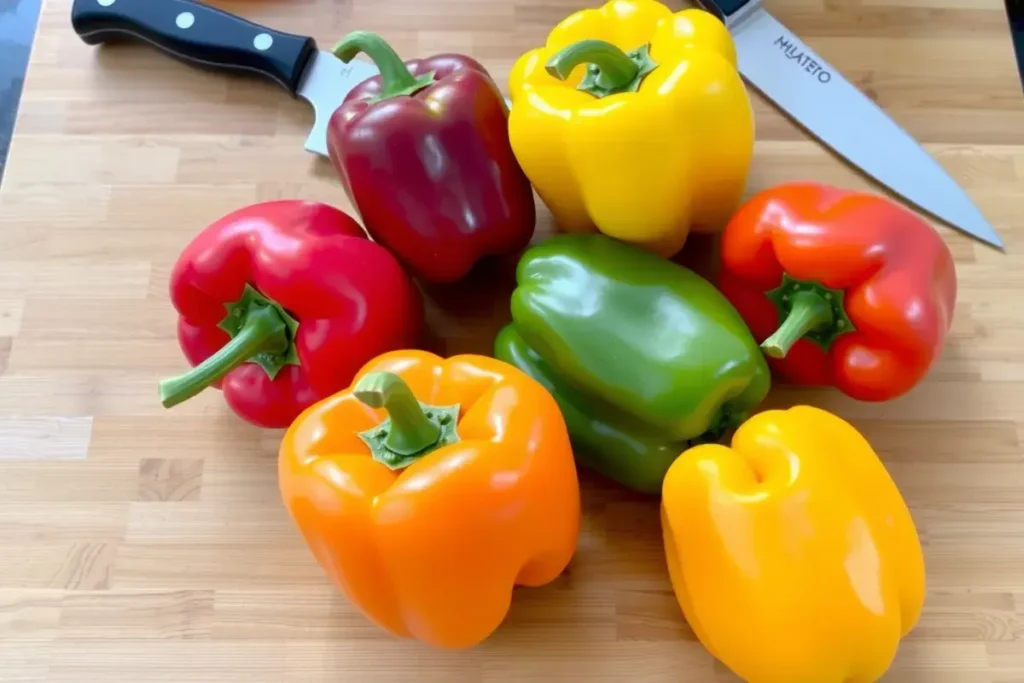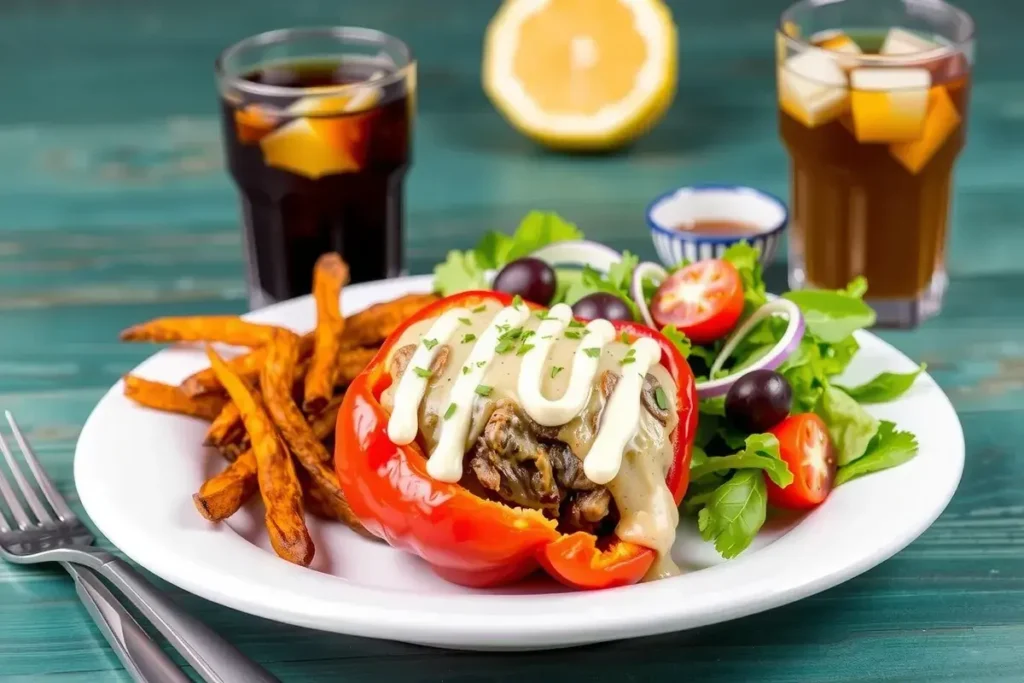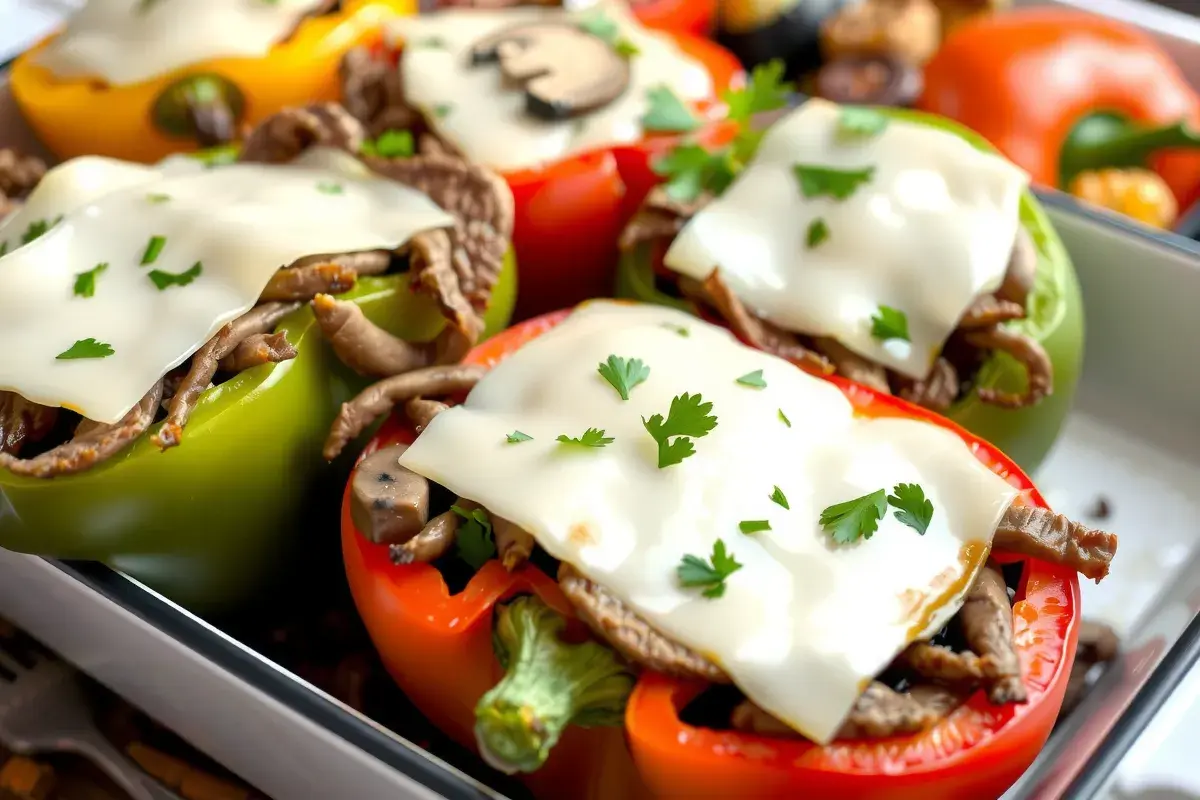Cheesesteak stuffed peppers bring the timeless flavors of a Philly cheesesteak into the comforting embrace of tender bell peppers. This dish merges juicy steak, sautéed onions, and melty cheese with the bright, earthy sweetness of peppers. The result is a flavorful meal that feels both homey and sophisticated.
Therefore, if you love a classic Philly cheesesteak, you will adore its stuffed-pepper counterpart. In this comprehensive guide, we will explore every detail of making cheesesteak stuffed peppers: from selecting the best peppers and meats to adding a personal touch with seasonings and cheeses. We will also walk you through step-by-step instructions, answer your most pressing questions, and even suggest tasty side dishes.
Why Cheesesteak Stuffed Peppers?
Many people admire Philly cheesesteaks but crave a lighter, vegetable-forward approach. Cheesesteak stuffed peppers solve that problem by delivering the delicious steak-and-cheese experience in a pepper “shell.” Bell peppers hold the savory mixture without the added carbs from bread.
However, this recipe is not just about reducing carbohydrates. It also highlights the natural sweetness of bell peppers, which harmonizes with seared steak. Meanwhile, onions and mushrooms provide a flavorful foundation. And melted cheese ties everything together. Consequently, the final result is an entrée that balances healthfulness and indulgence
Moreover, these peppers look vibrant on the dinner table. Their colorful exteriors hint at the mouthwatering filling inside. This is why cheesesteak stuffed peppers are perfect for parties or family get-togethers. They make a statement while satisfying appetites.
In this article, we will uncover the essential steps for choosing peppers and steak, handling onions and mushrooms, selecting the best cheese, and assembling the dish. We will also discuss time-saving strategies, cooking tips, and common mistakes to avoid. Therefore, read on to discover how you can transform your next meal into something extraordinary with cheesesteak peppers that are both delicious and visually stunning.
The Allure of Philly Cheesesteak in Pepper Form
Philly cheesesteaks evoke images of sizzling beef, caramelized onions, and gooey cheese sandwiched in a soft roll. When you incorporate these familiar flavors into peppers, you capture that same allure without sacrificing nutritional balance. Cheesesteak stuffed peppers keep the meaty essence while adding a fresh twist, and they are surprisingly easy to prepare.
Origins of the Cheesesteak
To understand why the cheesesteak has become so popular, it helps to explore its roots. Originating in Philadelphia, this iconic sandwich gained traction in the 1930s. It began with thinly sliced steak, onions, and cheese placed on a long roll. Over time, variations arose—some people love Cheez Whiz, while others prefer provolone or American cheese. Regardless, the essence remains the same: savory meat, melty cheese, and flavorful onions.
Why the Pepper Upgrade?
- Flavor Contrast: Peppers add a bright, garden-fresh sweetness that plays well against the richness of steak and cheese.
- Nutrient Boost: Bell peppers are high in vitamins A and C, making these stuffed peppers more nutritious than the standard sandwich.
- Visual Appeal: The colorful peppers present a fun way to serve this Philly favorite.
For example, when you serve cheesesteak stuffed peppers at gatherings, you can create a mix of red, yellow, and green peppers. Your guests will be impressed before they even taste what is inside.
Therefore, these stuffed peppers serve as a conversation starter, pleasing both die-hard cheesesteak fans and those seeking a lighter meal.
Choosing the Right Peppers for Cheesesteak Stuffed Peppers

The choice of pepper can elevate or hinder your final result. Not all peppers are equal in sweetness, texture, or size. Therefore, you need to consider color, shape, and cooking time to ensure the best possible outcome for your cheesesteak stuffed peppers.
Color Considerations
- Green Bell Peppers: Green peppers are slightly bitter but develop a pleasant flavor when cooked. They offer a contrasting taste that complements beef and cheese.
- Red Bell Peppers: Red peppers are sweeter and often become fork-tender when roasted. They pair beautifully with savory fillings.
- Yellow and Orange Bell Peppers: These peppers have a mild, sweet flavor and a bright color that adds visual appeal to your dish.
Although any color works, red, yellow, and orange peppers tend to be sweeter than green. For some, that sweetness is the ideal counterpart to salty, savory steak. However, you should choose according to personal preference.
Shape and Size
Peppers come in various shapes and sizes. Ideally, aim for peppers that can stand upright or be cut in half lengthwise without spilling. For instance, larger peppers can be halved to create a boat shape, which many people prefer for stuffed recipes. Meanwhile, smaller peppers (when kept whole) are great for appetizers or individual servings.
- Tip: Look for peppers with thick walls; these maintain their structure during cooking and hold more of the filling.
Preparing the Peppers
Before stuffing, you should remove the seeds and the white membranes inside. These parts can make the peppers taste bitter. Also, consider precooking peppers if you prefer a softer texture. For example, you can parboil them for a few minutes or roast them lightly before stuffing. However, some prefer a slight crunch, which requires less or no precooking.
Selecting the Perfect Steak for Cheesesteak Stuffed Peppers
Choosing the right steak ensures tenderness and flavor. Not all cuts respond the same way to quick cooking methods. Therefore, you want beef that remains tender when thinly sliced or chopped. Below are some popular choices:
- Ribeye: This cut is prized for its marbling, which keeps the meat juicy.
- Sirloin: It offers robust flavor at a more budget-friendly price.
- Flank Steak: Lean but flavorful, especially when cut against the grain.
- NY Strip: A tender cut that’s easy to slice thinly.
Cheesesteak stuffed peppers typically use thinly sliced beef. For instance, you can buy steak labeled “cheesesteak meat” at many supermarkets. If you prefer to slice at home, it helps to partially freeze the steak for about 30 minutes. That way, you can slice it more easily.
Marinating the Steak
While many traditional Philly cheesesteak recipes do not require marinating, a simple marinade can impart extra flavor. For example, you can marinate steak in Worcestershire sauce, salt, pepper, garlic powder, and a splash of olive oil for about 15–30 minutes. This brief marinade helps tenderize the meat. However, avoid overly acidic marinades, which might break down the meat too much.
Cooking the Steak
- Tip: Cook the steak in a hot skillet to develop a good sear.
- Sauté onions and mushrooms in the same pan to absorb the flavorful steak drippings.
- Avoid overcooking the steak, as it can become tough and dry.
Meanwhile, be mindful of salt content if you plan to use a cheese that is already salted. Balancing these elements ensures your cheesesteak stuffed peppers remain perfectly seasoned.
Crafting the Filling: Onions, Mushrooms, and More
No Philly cheesesteak is complete without onions. Therefore, onions are essential in cheesesteak stuffed peppers as well. Mushrooms also add an earthy undertone that complements the beef.
Sautéing Onions
Onions add sweetness and depth, which is crucial for recreating that authentic Philly cheesesteak taste. They should be cooked until they turn golden-brown and slightly caramelized. For example:
- Warm a tablespoon of oil or butter in a skillet over medium heat.
- Add thinly sliced onions and a pinch of salt.
- Stir occasionally and reduce heat if they start to brown too quickly.
This process unlocks the onions’ natural sweetness. Therefore, they become a savory-sweet companion to the steak.
Including Mushrooms
Mushrooms bring a meaty texture and can stretch your steak supply further. Choose varieties like cremini or baby bella. Sauté them in the same skillet used for the onions so they absorb leftover flavor. Add a little butter or oil, and cook until they release moisture and begin to brown.
- Tip: Season the mushrooms with a dash of garlic powder or fresh thyme for extra complexity.
Additional Vegetables and Flavors
- Bell Peppers: You can use leftover pepper trimmings (from shaping the peppers) to sauté alongside onions.
- Jalapeños or Poblanos: For heat, toss in diced jalapeños or poblanos.
- Garlic: Minced garlic adds a pungent kick, so use it to taste.
In other words, consider your preferences. Cheesesteak fillings are flexible, so feel free to add or remove ingredients. However, remember that each addition affects the overall taste and texture. Use moderation to preserve that classic cheesesteak essence.
Best Cheeses for Cheesesteak Stuffed Peppers
Cheese choice can dramatically change the experience. While the original Philly cheesesteak often uses Cheez Whiz, provolone or American cheese are also common. For cheesesteak stuffed peppers, you can be creative while still honoring tradition.
Provolone vs. American vs. Cheddar
- Provolone: Offers a mild, tangy flavor and melts beautifully.
- American: Creates that classic gooey consistency and iconic cheesesteak flavor.
- Cheddar: Adds a sharper taste that some people love, although it is not traditionally used in Philly cheesesteaks.
For example, you can mix provolone with a little cheddar if you like a stronger flavor. However, if you want a truly classic approach, stick to American cheese or mild provolone.
Cheese Slices vs. Shredded Cheese
- Slices: Simplify the process by placing slices on top of each pepper or layering them between steak and onions.
- Shredded Cheese: Distributes more evenly and creates a golden-brown crust when baked.
Therefore, use whichever form suits your cooking style. Both yield delicious, melty results.
Step-by-Step Recipe for Cheesesteak Stuffed Peppers
Now that you understand the key elements, let’s dive into a comprehensive recipe. Follow these steps to make about four servings.
Ingredients
- 4 large bell peppers (any color), halved and seeded
- 1 pound thinly sliced steak (ribeye, sirloin, or flank)
- 1 large onion, thinly sliced
- 8 ounces mushrooms, sliced
- 2 tablespoons olive oil (divided)
- 1 tablespoon Worcestershire sauce (optional)
- 1 teaspoon salt
- 1 teaspoon black pepper
- 1 teaspoon garlic powder
- 8 slices provolone cheese or 2 cups shredded provolone (approx.)
Optional:
- 1 jalapeño, diced
- 1 tablespoon chopped fresh parsley, for garnish
Equipment
- Large skillet or cast-iron pan
- Baking dish or sheet tray
- Mixing bowl (for optional marinade)
- Aluminum foil (if precooking peppers)
Instructions
- Preheat Your Oven
- Set the oven to 375°F (190°C). This ensures the peppers cook evenly.
- Prepare the Peppers
- Halve and seed the peppers.
- Decide if you want to precook them. For a softer texture, place them on a baking sheet, drizzle lightly with oil, and bake for 10 minutes.
- Marinate (Optional)
- If you prefer extra flavor, marinate the steak with Worcestershire sauce, salt, pepper, and garlic powder for 15–30 minutes.
- Sauté the Onions and Mushrooms
- Warm 1 tablespoon of olive oil in a skillet over medium heat.
- Add onions; cook until they turn golden-brown.
- Toss in mushrooms; cook until they release moisture and begin to brown.
- Season lightly with salt and pepper. Set aside.
- Cook the Steak
- In the same skillet, add the remaining tablespoon of olive oil.
- Raise the heat to medium-high.
- Cook the thinly sliced steak in batches, ensuring each piece gets a quick sear. Avoid crowding the pan.
- Return onions and mushrooms to the skillet; mix with the steak. Adjust seasonings if needed.
- Assemble the Peppers
- Arrange the pepper halves in a baking dish or on a sheet tray.
- Fill each pepper with a generous scoop of the steak-onion-mushroom mixture.
- Top with a slice or handful of cheese.
- Bake
- Bake in the preheated oven for 15–20 minutes, or until the cheese is melted and bubbly.
- If you want a golden crust, switch to the broiler for the last 2–3 minutes.
- Garnish and Serve
- Remove from the oven and let them rest for a couple of minutes.
- Sprinkle fresh parsley on top if desired.
- Serve warm and enjoy.
Pro Tip: You can prepare parts of this dish in advance by cooking the filling the day before. Then, stuff the peppers just before baking. This saves time and makes weeknight dinners a breeze.
Serving Suggestions and Side Dishes of cheesesteak stuffed peppers

Cheesesteak stuffed peppers are hearty enough to serve as a main course. However, consider complementing them with side dishes that enhance their savory appeal.
- Side Salad: A crisp green salad with a light vinaigrette offsets the richness of the peppers.
- Roasted Vegetables: Broccoli, cauliflower, or carrots add color and extra nutrients.
- Sweet Potato Fries: The sweetness of these fries balances the savory stuffed peppers.
- Garlic Bread: If you want a more traditional cheesesteak vibe, serve it alongside crusty bread for dipping.
For example, you might serve these peppers with a tangy coleslaw to offer contrast. Meanwhile, potato wedges satisfy those who love a classic steak-and-potatoes combination.
Therefore, you can tailor the sides to match your personal preferences or dietary needs. The stuffed peppers are versatile enough to pair with a range of side dishes, so feel free to get creative.
Flavor Variations and Customizations of cheesesteak stuffed peppers
Once you have mastered the basic version of cheesesteak stuffed peppers, it is easy to experiment. Here are a few fun ideas to spark your creativity:
- Spicy Kick
- Add sliced jalapeños or a dash of hot sauce to the steak mixture.
- Top with pepper jack cheese for extra heat.
- Italian-Inspired
- Swap the steak for ground Italian sausage.
- Use mozzarella and a sprinkle of Parmesan cheese.
- Add fresh basil leaves before serving.
- Southwestern Twist
- Season the steak with taco seasoning.
- Use poblano peppers for a smoky flavor.
- Top with cheddar or Monterey Jack cheese, plus chopped cilantro.
- Mushroom Lover’s
- Double the mushroom quantity.
- Use Swiss cheese for a unique, nutty taste.
For example, you can even experiment with leftover roasted vegetables, mixing them into the filling. Therefore, do not be afraid to adapt the recipe to your liking. The possibilities are endless.
Time-Saving Techniques and Meal Prep Tips of cheesesteak stuffed peppers
Although cheesesteak stuffed peppers might seem involved, they can be streamlined for busy schedules. Use these tips to reduce your cooking time:
- Pre-Sliced Meat: Many grocery stores sell pre-sliced steak labeled “cheesesteak beef.”
- One-Pan Approach: Sauté onions, mushrooms, and steak in the same pan to cut down on cleanup.
- Batch Cooking: Make a large batch of filling. Store leftovers in the fridge or freezer, so you only need to stuff and bake when ready to eat.
- Precook the Peppers: Parboil or roast peppers in advance, then store them in the fridge. This way, you can quickly assemble and bake.
In other words, you can have most of the work done ahead of time. Therefore, on a busy weekday, you can still enjoy a delicious, homemade meal without stress.
Common Pitfalls and How to Avoid Them on cheesesteak stuffed peppers
When making cheesesteak stuffed peppers, certain mistakes can compromise flavor and texture. Below are frequent pitfalls and how to address them:
- Overcooking the Steak
- Thin slices of steak cook fast. Monitor carefully to keep the meat juicy.
- Under-Seasoning
- The peppers, steak, and onions all need adequate seasoning.
- Taste as you go, adjusting salt and pepper as needed.
- Soggy Peppers
- If you parboil peppers for too long, they may become mushy.
- Keep parboiling to a minimum and consider roasting instead.
- Cheese Overflow
- Use enough cheese to cover the filling but do not overstuff the peppers.
- If cheese drips, it may burn on the baking sheet.
- Insufficient Baking Time
- Peppers need time to soften. Check their tenderness with a fork.
Therefore, managing these details ensures your cheesesteak stuffed peppers turn out juicy, tender, and delicious.
FAQ: cheesesteak stuffed peppers
What is the secret ingredient in Philly cheesesteak?
Many say the secret lies in Worcestershire sauce, which enhances the beefy flavor. Others argue it’s the caramelized onions that make all the difference. Classic Philly cheesesteak purists might insist the real “secret” is using the right cut of meat (often ribeye) and cooking it on a seasoned grill or griddle. In reality, it’s the synergy of tender beef, onions, and cheese that creates the iconic taste.
Should peppers be precooked before stuffing?
You do not have to precook peppers, but it helps achieve a softer texture. Parboiling or pre-roasting peppers for a short time can reduce overall baking time. However, if you enjoy a firmer bite, you can stuff them raw and bake until the cheese is melted and the peppers reach your desired tenderness.
What peppers are good for cheesesteak?
Traditional recipes call for bell peppers. Their natural sweetness pairs well with savory fillings. Red, yellow, or orange bell peppers tend to be sweeter, while green peppers have a more pronounced, mildly bitter taste. Some people also use poblano peppers to add a smoky twist to their cheesesteak creations.
What sauce goes on Philly cheesesteak?
Classic Philly cheesesteaks often do not use an additional sauce beyond melted cheese. However, some like a drizzle of cheese sauce (like Cheez Whiz) or a bit of mayonnaise. A few prefer ketchup or hot sauce. For cheesesteak stuffed peppers, you can experiment with condiments such as aioli or spicy mayo. It depends entirely on personal preference.
Conclusion: Elevate Your Next Meal with Cheesesteak Stuffed Peppers
Cheesesteak stuffed peppers offer a dazzling way to enjoy the flavors of a classic Philly cheesesteak. They bring together savory steak, caramelized onions, gooey cheese, and the vibrant sweetness of roasted peppers. Moreover, this dish is surprisingly easy to customize, whether you want more spice, extra veggies, or different cheese blends.
Therefore, do not hesitate to try this recipe for your next family dinner or potluck. The aroma alone will bring everyone to the kitchen, and the rich, satisfying flavors will ensure not a single pepper is left over. In the end, these peppers stand as a testament to how simple ingredients—properly seasoned and cooked—can transform into a memorable meal.

